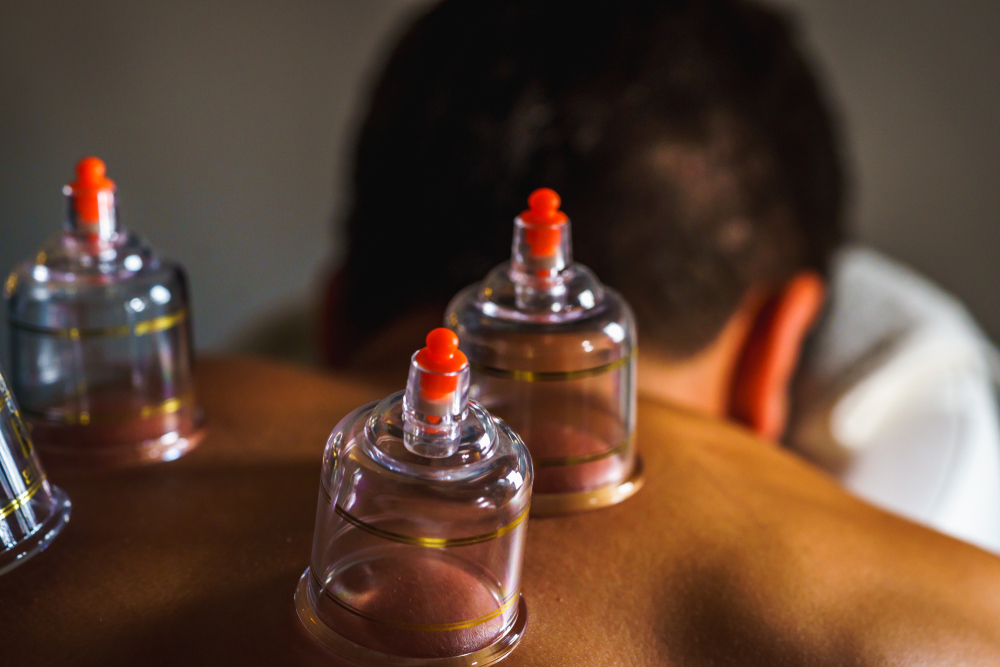At Butler Spine & Sport, we understand that managing muscle tension and promoting tissue healing requires innovative therapeutic approaches. Cupping therapy is an ancient healing technique that has found new applications in modern sports medicine and rehabilitation. This gentle yet effective treatment uses specially designed cups to create therapeutic suction that helps relieve muscle tension, increase blood flow, and accelerate recovery for athletes and active individuals.
Cupping
Understanding Cupping
Cupping therapy involves placing specialized cups on the skin to create a controlled vacuum effect that gently lifts the tissue layers. This therapeutic suction promotes increased circulation and tissue mobility in targeted areas. The technique can be applied using either stationary cups or through dynamic movements, where the cups glide across the skin. Modern cupping methods combine traditional wisdom with a contemporary understanding of anatomy and physiology to deliver precise, effective treatment for various musculoskeletal conditions.
Benefits of Cupping
- Neuromuscular Reset
- Fascial Decompression
- Lymphatic System Activation
- Trigger Point Release
- Tissue Hydration
Neuromuscular Reset
Cupping therapy creates a unique neurological response in your body’s tissues that helps reset dysfunctional movement patterns. This neurological effect can help reduce muscle guarding and chronic tension that develops from injury or stress. The treatment stimulates specialized nerve endings in your soft tissues, promoting better muscle function and coordination. The gentle vacuum effect helps your nervous system adapt to more optimal movement strategies.
Fascial Decompression
The negative pressure created by cupping provides a unique way to decompress restricted fascial layers throughout your body. This decompression effect helps restore the natural sliding and gliding properties of your connective tissue system. The treatment creates space between tissue layers that have become adhered or compressed over time. Regular sessions help maintain optimal fascial health and prevent the development of new restrictions.
Lymphatic System Activation
Cupping therapy provides powerful stimulation to your lymphatic system, enhancing your body’s natural detoxification processes. The suction effect helps move stagnant lymph fluid and reduce tissue congestion that can develop from injury or inactivity. This improved lymphatic flow helps reduce swelling and inflammation while supporting your immune system function. The treatment can be particularly beneficial after intense exercise or injury when lymphatic circulation is crucial for recovery.
Trigger Point Release
Cupping offers an effective approach for releasing stubborn trigger points without the direct pressure often used in other treatments. The vacuum effect helps dissipate these irritable spots in your muscles through gentle tissue decompression rather than compression. This makes the treatment particularly useful for sensitive areas that don’t respond well to direct pressure. The sustained lift created by the cups helps break the pain-spasm cycle that maintains trigger points.
Tissue Hydration
The unique actions of cupping help improve the hydration levels of your soft tissues by enhancing fluid exchange at the cellular level. This improved tissue hydration helps restore optimal flexibility and function to muscles and fascia. The treatment creates a pumping effect that helps distribute tissue fluids more effectively throughout treated areas. Better tissue hydration leads to improved mobility and reduced risk of injury during activity.

Our Cupping Process
Why Choose Us for Cupping
Our team at Butler Spine & Sport combines extensive training in modern cupping techniques with a deep understanding of sports medicine and rehabilitation principles. We take pride in delivering precise, effective treatments that help our patients achieve their recovery and performance goals. Our experience working with athletes and active individuals gives us unique insight into movement patterns and tissue dysfunction, allowing us to provide more targeted and effective cupping treatments.

Start Your Healing Journey Today
Don’t let muscle tension and restricted movement hold you back from performing at your best. Experience the therapeutic benefits of professional cupping therapy.
Schedule your free consultation today and discover how our specialized cupping techniques can help you achieve optimal movement and function.
FAQs About Cupping
What does cupping therapy do?
Cupping therapy creates a therapeutic vacuum effect that increases blood flow and promotes tissue healing. The treatment helps release muscle tension, reduce inflammation, and improve circulation to targeted areas. This combination of effects can help reduce pain, improve mobility, and accelerate recovery from both exercise and injury.
Does cupping therapy work?
Research and clinical experience show that cupping therapy is effective for various musculoskeletal conditions. The treatment has demonstrated particular success in reducing muscle pain, improving range of motion, and accelerating recovery from intense physical activity. While individual results may vary, many patients report significant improvement after just a few sessions.
Does cup therapy hurt?
Cupping therapy typically creates a unique sensation of tissue lifting that most patients find comfortable and relaxing. While you may experience some temporary skin marking from the suction effect, the treatment itself should not be painful. The intensity can be adjusted to ensure your comfort throughout the session.
How does cupping therapy work?
Cupping works by creating negative pressure that lifts and separates tissue layers, increasing blood flow and promoting healing. The suction effect helps release adhesions, reduce muscle tension, and stimulate your body’s natural healing responses. This mechanical and physiological effect helps improve tissue mobility and function.
How often can you do cupping therapy?
The frequency of cupping treatments depends on your specific condition and treatment goals. Some patients benefit from weekly sessions during active treatment phases, while others maintain results with monthly maintenance sessions. Your practitioner will recommend an optimal treatment schedule based on your individual needs and response to treatment.


